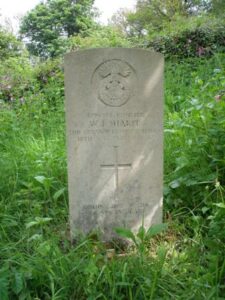St. Ishmael’s was an early Christian settlement, probably built on a Bronze Age site, and is sited west of Milford Haven, in a picturesque seaside location. The men of the Parish who fell during the Great War of 1914-1918 are commemorated on a marble plaque, which is affixed to the wall of the Memorial Hall. There are also plaques inside the Parish Church which commemorate Lieutenant Henry William Warren Davis, of the Welsh Regiment, who fell during the Great War, and also for William Ormond who fell during World War Two.
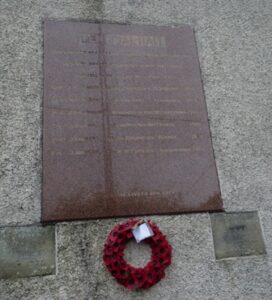
The Great War, 1914-1918
Henry William Warren Davis, Lieutenant, Welsh Regiment. Henry was born on 27 December 1891, the son of Henry Warren Davis and Christobel Warren Davis, of The Warren, Milford Haven. He was educated at Malvern College, before attending Sandhurst, and was gazetted Second Lieutenant into the Welsh Regiment on 14 February 1912. Henry was a Lieutenant with the 1st Battalion, Welsh Regiment at the outbreak of war, and moved to France in January 1915 with the Battalion, which was attached to 84 Brigade, 28th Division. The 1st Welsh saw their first major action during the Second Battle of Ypres. The 1st Welsh were near Zonnebeke, and were receiving hits from a German trench mortar. On 18 April 1915, Henry was sent out in charge of a party of bombers from B Company, to destroy the Trench Mortar. He was killed while stooping down to aid a wounded man during the assault. Henry was 24 years old, and was buried at Zonnebeke. His grave was lost during further fighting in the area, so Henry is commemorated by a Special Memorial within Bedford House Cemetery, Belgium. The History of the Welsh Regiment records; ‘Lieutenant Davis was a great loss—a fine sportsman and an excellent bomber and shot, he was developing into an invaluable sniping expert.’ In ‘The Hungry One’, by C. P. Clayton, Henry is noted as being called ‘Crwt’ among his fellow officers, and was totally fearless, being acting against orders when attempting to rescue wounded men in No Man’s Land when he was killed.
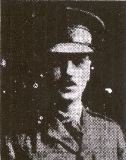
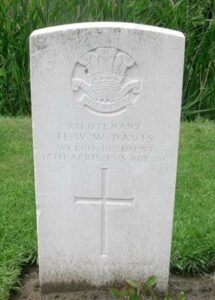
Sidney Davies, Private, 5777, Welsh Regiment. Sidney was the son of Thomas and Emma Davies, of Great Hoaten, St. Ishmaels. He enlisted at Carmarthen into the 4th Battalion, Welsh Regiment, which was the local territorial infantry battalion. Sidney didn’t serve overseas, but was on home service with the 4th Welsh when he died on 8 December 1916, aged 29, and is buried in St. Ishmael’s (St. Ishmael) Churchyard.
Frederick Seymour Jenkins, Sapper, 15443, Royal Engineers. Frederick was born at St. Ishmael’s in 1885, the son of Mathew Jenkins and Harriet Jenkins (nee Stephens), of Goose Green. He was an army reservist and was working at Portsmouth in the Royal Naval Dockyard when he married Eva May Loader in 1913. At the outbreak of war Frederick was recalled to the colours and rejoined the 55th Field Company, Royal Engineers, which was attached to the 7th Division. The Division was formed during September 1914 and landed at Zeebrugge on 6 October 1914. The City was already falling however, and so the Division was moved to Ypres, where they became the first British Division to hold the city. They fought during the First Battle of Ypres, and helped stop the German advance through Belgium. Frederick was killed in action soon after the Division moved to the Fleurbaix sector, at a place called La Cordonnerie, on 9 December 1914. He was 29 years old, and is buried at Rue-Petillon Military Cemetery, Fleurbaix, France. Frederick was St. Ishmael’s first casualty of the Great War. His widow was left with their young daughter Olive to raise alone and died on 16 April 1973, aged 80, after having never remarried.
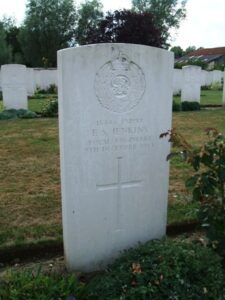
George Hugh Jenkins, Private, 4651, Manchester Regiment. Hugh was born at St. Ishmael’s in 1884, the son of William Jenkins, and Mary Ann Jenkins (nee Thomas). He enlisted at Fleetwood, Lancashire at some time prior to the war, and joined the 1st Battalion, Manchester Regiment. At the outbreak of war, the Battalion was at Jullundur, India, as part of the 8th (Jullundur) Brigade, 3rd (Lahore) Division. This Division left India on 29 August 1914 as part of the Indian Corps and moved to France, landing at Marseilles on 26 September 1914. It served on the Western Front until leaving France on 10 December 1915, whereupon it moved to Mesopotamia, landing at Basra on 8 January 1916. Hugh was killed during the attempt to relieve the besieged garrison at Kut on 8 March 1916, aged 31. He is commemorated on the Basra Memorial, Iraq.
George Benjamin John, Private, G/7117, Queens Own Royal West Kent Regiment. George was born in 1894, the son of Charles and Martha John, of St. Ishmael’s. He originally enlisted at Haverfordwest into the 16th Lancers, but was transferred at some time into the 1st Battalion, Royal West Kent Regiment. The battalion was in France attached to 13 Brigade, 5th Division. The Division had landed at Havre on 15 August, 1914, and fought at the Battle of Mons, and during the retreat south, fighting at Le Cateau, then down to the Marne where the German attack was halted. They took part in the advance to the Aisne, before moving to Flanders, where they fought at the Battle of La Bassée, then at Messines in October, 1914. They fought here through First Ypres, and took part in the capture of Hill 60, and then fought at Second Ypres in April 1915. March 1916 saw the Division moving to positions between St. Laurent-Blangy and Vimy, near Arras, and the Division saw plenty of action during it’s spell here. On 1 July 1916 the Battle of the Somme opened, and the Division moved south fighting at High Wood, then at Guillemont, and Flers-Courcelette. George was wounded at Flers, and evacuated to the Casualty Clearing Station at Corbie, in the Somme Valley. He died of his wounds there on 15 September 1916, aged 22, and is buried at La Neuville British Cemetery, Corbie, France.
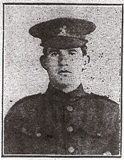
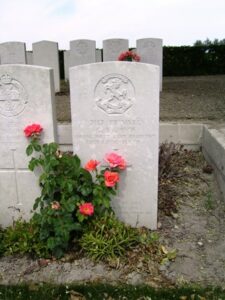
James Lambert, Sapper, 165171, Royal Engineers. James was born at St. Ishmael’s in 1884, the son of John and Maria Lambert. He married Alice Mary Harried, of Herbrandston, in 1908 and the couple lived at St. Ishmaels, where their four children were born. James enlisted at Haverfordwest into the Royal Engineers. He was posted to France to join the 288th Army Troops Company, Royal Engineers. The unit was employed for work behind the lines, building bridges and water works. James was caught up in the German Offensive on the Somme in March 1918, possibly while working on bridge demolition, and was killed on 30 March 1918, aged 31. He has no known grave, and is commemorated on the Pozières Memorial, France.
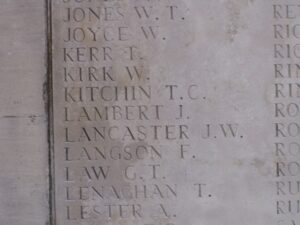
John Morgan, Private, 13329, Royal Welsh Fusiliers. John was born in 1880, the son of Henry and Mary Morgan, of St. Ishmael’s. He lived with his wife, Emma Morgan, at Landwr, Ambleston, Treffgarne. John enlisted at Tonypandy into the 8th Battalion, Royal Welsh Fusiliers, which was attached to 40 Brigade, 13th (Western) Division. The Division landed at Gallipoli in July 1915, and relieved the 29th Division, before moving to ANZAC. They experienced heavy fighting until being evacuated from on 8 January 1916, and by 31 January was concentrated at Port Said, where they held forward posts in the Suez Canal defences. On 12 February 1916 the Division began to move to Mesopotamia, to strengthen the force being assembled for the relief of the besieged garrison at Kut al Amara. By 27 March, the Division had assembled near Sheikh Saad and came under orders of the Tigris Corps, and then took part in the attempts to relieve Kut. However, after these efforts failed and Kut fell, the British force in the theatre was built up and reorganised. The Division then fought at the Battle of Kut al Amara, then at the capture of the Hai Salient and the capture of Dahra Bend. John was one of many men who fell in during the campaign in Mesopotamia. He died on 1 June 1916, aged 35, and is buried at Basra War Cemetery, Iraq.
William Morris, Private, 14740, Welsh Regiment. William was born in 1897, the son of David and Ellen Morris, of East Lodge, St. Ishmaels, Milford Haven. He enlisted at Milford into the 9th Battalion, Welsh Regiment, which was attached to 58 Brigade, 19th (Western) Division. The Division crossed to France during July 1915, and moved to positions around Givenchy, near Loos. William was wounded soon after, and died of his wounds on 23 August 1915. He was 19 years old, and is buried at Merville Communal Cemetery, France. William is not commemorated at St. Ishmael’s.
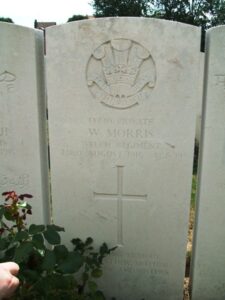
Alfred Claude Thomas, Private, 12285, Royal Welsh Fusiliers. Alfred was the son of Arthur and Alice Thomas, of St. Ishmael’s, Milford Haven. He enlisted at Haverfordwest into the army, and was posted to the 10th Battalion, Royal Welsh Fusiliers, which was attached to 76 Brigade, 25th Division, and landed at Boulogne on 27 September 1915. The Brigade then moved to 3rd Division, which was at Ypres. The 10th RWF saw their first action at Bellewaarde and Hooge, and took part in the Second attack on Bellewaarde. During 1916 the Division fought at the Actions of the Bluff, and at the St Eloi Craters. They were then moved south to the Somme, where they were to take part in the great Battle of the Somme, and fought there at the Battle of Albert, and at the Battle of Bazentin, where they captured Longueval. Alfred was killed here on 20 July 1916. He was 23 years old, and is buried at Delville Wood Cemetery, Longueval, France. Alfred is not commemorated on the St Ishmaels Memorial.
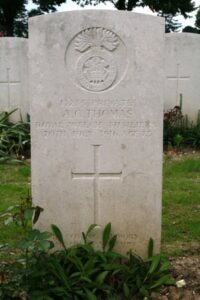
World War Two, 1939-1945
William John Ormond, Aircraftman 1st Class, 1300537, Royal Air Force Volunteer Reserve. William was born on 22 December 1909, the son of George Ormond and Elizabeth Ann Ormond (nee James), of The Glebe, Hasguard, Pembrokeshire. William worked as a labourer prior to enlisting into the Royal Air Force Volunteer Reserve soon after the outbreak of war and was posted to RAF Tengah, at Singapore, a new airfield which had opened in 1939. On 8 February 1942 the Japanese launched an assault against the British stronghold of Singapore and after six days of brutal fighting, the commanding officer of Singapore, Lieutenant-General Arthur Percival, surrendered. William had initially been evacuated with a number of other RAF personnel to Java, but was captured there on 3 March, joining some 80,000 troops taken captive by the Japanese following the surrender, and was eventually taken to a POW Camp at Sandakan Island, Borneo. He survived over two years in captivity before dying of malaria at Sandakan on 4 September 1944, aged 34. He was originally buried on Sandakan, but after the war the graves of the POW’s there were exhumed and moved to Labuan War Cemetery, in Malaysia. His mother, Elizabeth, had died in 1917 and was buried in Aenon Baptist Chapelyard, near Herbrandston.
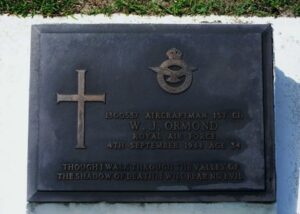
William James Sharpe, Fusilier, 4199702, Royal Welch Fusiliers. William was the son of John Henry and Mary Jane Sharpe of St. Ishmaels. He served with the 4th Battalion, Royal Welch Fusiliers, which was attached to 158 Brigade, 53rd (Welsh) Division. The division remained on home service for the early years of the war, and landed in Normandy in June 1944. William died whilst still on home service, on 18 May 1943. He was 27 years old, and is buried at St. Ishmael’s Churchyard.
